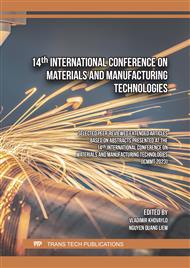[1]
N. de Guzman and M. D. L. Balela, "Growth of Ultralong Ag Nanowires by Electroless Deposition in Hot Ethylene Glycol for Flexible Transparent Conducting Electrodes," J Nanomater, vol. 2017, 2017.
DOI: 10.1155/2017/7896094
Google Scholar
[2]
M. D. L. Balela, S. B. Orgen, and M. R. Tan, "Fabrication of Highly Flexible Copper Nanowires in Dual Surfactant Hydrothermal Process," J Nanosci Nanotechnol, vol. 19, no. 11, p.7156–7162, 2019.
DOI: 10.1166/jnn.2019.16714
Google Scholar
[3]
B. F. Y. Rezaga and M. D. L. Balela, "Synthesis and characterization of nickel-coated copper nanowires for flexible conductive thin film applications," Mater Today Proc, vol. 22, p.241–247, 2020.
DOI: 10.1016/j.matpr.2019.08.094
Google Scholar
[4]
M. R. Tan and M. D. L. Balela, "Electrochemical investigation of the growth of copper nanowires in the presence of ethylenediamine through mixed potential," J Electrochem Soc, vol. 164, no. 7, pp. D386–D393, 2017.
DOI: 10.1149/2.0491707jes
Google Scholar
[5]
N. De Guzman, M. Ramos, and M. D. Balela, "Improvements in the electroless deposition of Ag nanowires in hot ethylene glycol for resistive touchscreen device," Mater Res Bull, vol. 106, p.446–454, Oct. 2018.
DOI: 10.1016/j.materresbull.2018.06.030
Google Scholar
[6]
J. Zhao, D. Zhang, and X. Zhang, "Preparation and characterization of copper/silver bimetallic nanowires with core-shell structure," Surface and Interface Analysis, vol. 47, no. 4, p.529–534, 2015.
DOI: 10.1002/sia.5743
Google Scholar
[7]
X. Liu and Y. Zhou, "Electrochemical synthesis and room temperature oxidation behavior of Cu nanowires," J Mater Res, vol. 20, no. 9, p.2371–2378, 2005.
DOI: 10.1557/JMR.2005.0288
Google Scholar
[8]
Y. Chang, M. L. Lye, and H. C. Zeng, "Large-scale synthesis of high-quality ultralong copper nanowires," Langmuir, vol. 21, no. 9, p.3746–3748, 2005.
DOI: 10.1021/la050220w
Google Scholar
[9]
A. Morteza, P. Aekachan, L. Sangjun, R. Seunghwa, and P. Inkyu, "Highly stretchable and sensitive strain sensor based on silver nanowire-elastomer nanocomposite," ACS Nano, vol. 8, no. 5, p.5154–5163, 2014.
DOI: 10.1021/nn501204t
Google Scholar
[10]
S. Yao and Y. Zhu, "Wearable multifunctional sensors using printed stretchable conductors made of silver nanowires," Nanoscale, vol. 6, no. 4, p.2345–2352, 2014.
DOI: 10.1039/c3nr05496a
Google Scholar
[11]
G. Aroganam, N. Manivannan, and D. Harrison, "Review on Wearable Technology Sensors Used in Consumer Sport Applications," Sensors (Basel), vol. 19, no. 9, 2019.
DOI: 10.3390/s19091983
Google Scholar
[12]
D. Ponnamma, C. W. Kishor Kumar Sadasivuni, S. Thomas, and M. A.-A. AlMa'adeed, "Flexible and Stretchable Electronic Composites," p.390, 2016.
DOI: 10.1007/978-3-319-23663-6
Google Scholar
[13]
E. R. P. Pinto et al., "Transparent composites prepared from bacterial cellulose and castor oil based polyurethane as substrates for flexible OLEDs," J Mater Chem C Mater, vol. 3, no. 44, p.11581–11588, 2015.
DOI: 10.1039/c5tc02359a
Google Scholar
[14]
Y. Luan, Y. Park, and J. S. Noh, "The effects of a cationic surfactant on copper nanowires and their dimensions," Mater Chem Phys, vol. 184, p.279–284, 2016.
DOI: 10.1016/j.matchemphys.2016.09.052
Google Scholar
[15]
M. Tan and M. D. Balela, "Oleylamine assisted synthesis of ultralong copper nanowires," MATEC Web of Conferences, vol. 27, p.10–13, 2015.
DOI: 10.1051/matecconf/20152703003
Google Scholar
[16]
D. Bochicchio and R. Ferrando, "Morphological instability of core-shell metallic nanoparticles," Phys Rev B Condens Matter Mater Phys, vol. 87, no. 16, p.1–13, 2013.
DOI: 10.1103/PhysRevB.87.165435
Google Scholar
[17]
Z. Liu et al., "Synthesis of Copper Nanowires via a Complex-Surfactant-Assisted Hydrothermal Reduction Process," Journal of Physical Chemistry B, vol. 107, no. 46, p.12658–12661, 2003.
DOI: 10.1021/jp036023s
Google Scholar
[18]
Y. Shi, H. Li, L. Chen, and X. Huang, "Obtaining ultra-long copper nanowires via a hydrothermal process," Sci Technol Adv Mater, vol. 6, no. 7, p.761–765, 2005.
DOI: 10.1016/j.stam.2005.06.008
Google Scholar
[19]
R. Ferrando, J. Jellinek, and R. L. Johnston, "Nanoalloys: From theory to applications of alloy clusters and nanoparticles," Chem Rev, vol. 108, no. 3, p.845–910, 2008.
DOI: 10.1021/cr040090g
Google Scholar
[20]
M. A. Cruz et al., "Multigram Synthesis of Cu-Ag Core – Shell Nanowires Enables the Production of a Highly Conductive Polymer Filament for 3D Printing Electronics," vol. 1700385, p.1–10, 2018.
DOI: 10.1002/ppsc.201700385
Google Scholar
[21]
M. J. Catenacci, C. Reyes, M. A. Cruz, and B. J. Wiley, "Stretchable Conductive Composites from Cu–Ag Nanowire Felt," ACS Nano, vol. 12, no. 4, p.3689–3698, Apr. 2018.
DOI: 10.1021/acsnano.8b00887
Google Scholar
[22]
S. W. Chee, S. F. Tan, Z. Baraissov, M. Bosman, and U. Mirsaidov, "Direct observation of the nanoscale Kirkendall effect during galvanic replacement reactions.," Nat Commun, vol. 8, no. 1, p.1224, Dec. 2017.
DOI: 10.1038/s41467-017-01175-2
Google Scholar
[23]
Y. Lu, H. S. Kang, Y. S. Lim, B. C. Lee, S. H. Kim, and L. Piao, "The facile fabrication of hollow Cu2O nanoparticles induced by the Kirkendall effect on Cu@Ag core-shell nanoparticles," Bull Korean Chem Soc, vol. 36, no. 8, p.2150–2153, Aug. 2015.
DOI: 10.1002/bkcs.10401
Google Scholar
[24]
H. J. Fan, U. Gösele, and M. Zacharias, "Formation of nanotubes and hollow nanoparticles based on kirkendall and diffusion processes: A review," Small, vol. 3, no. 10. p.1660–1671, Oct. 2007.
DOI: 10.1002/smll.200700382
Google Scholar



